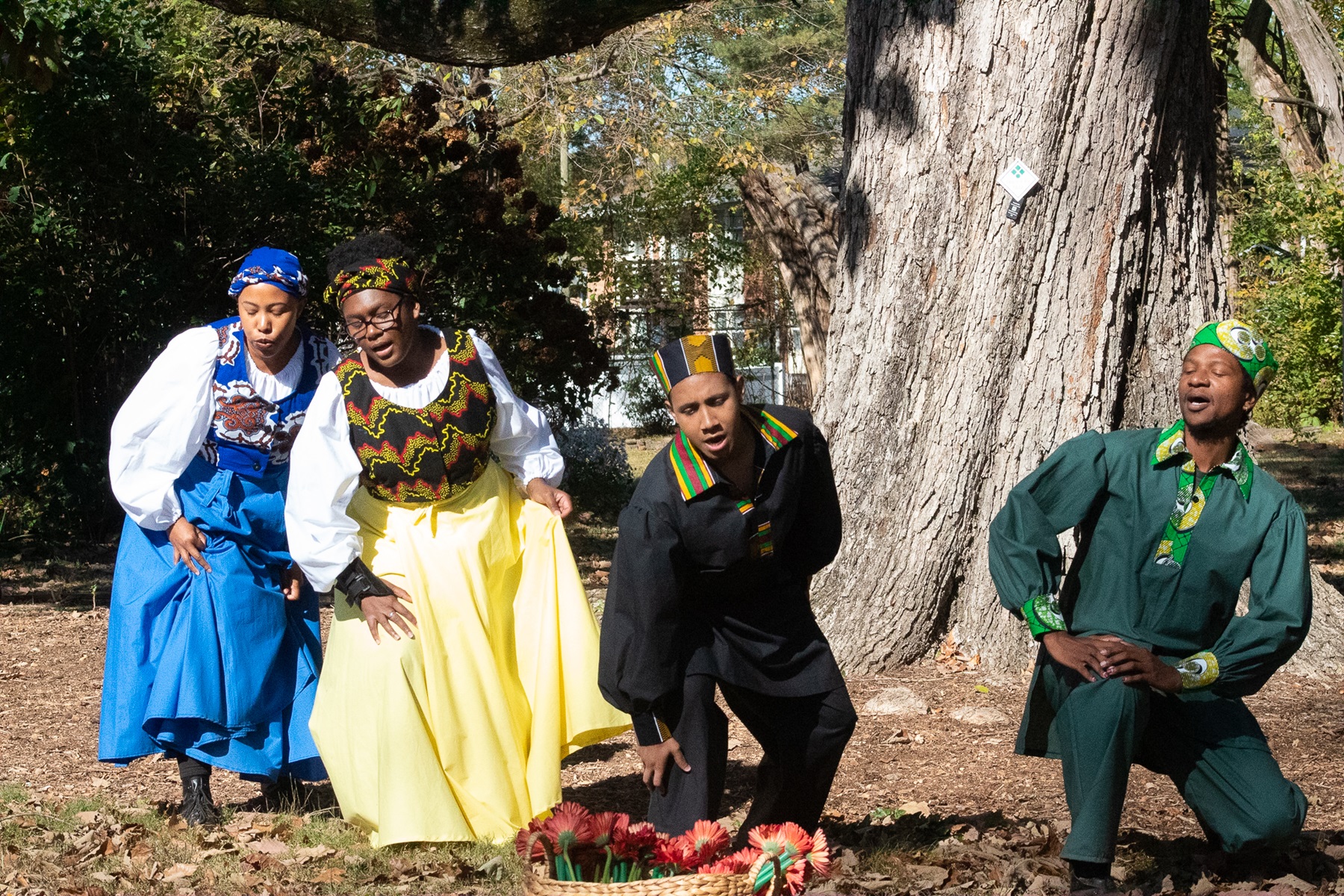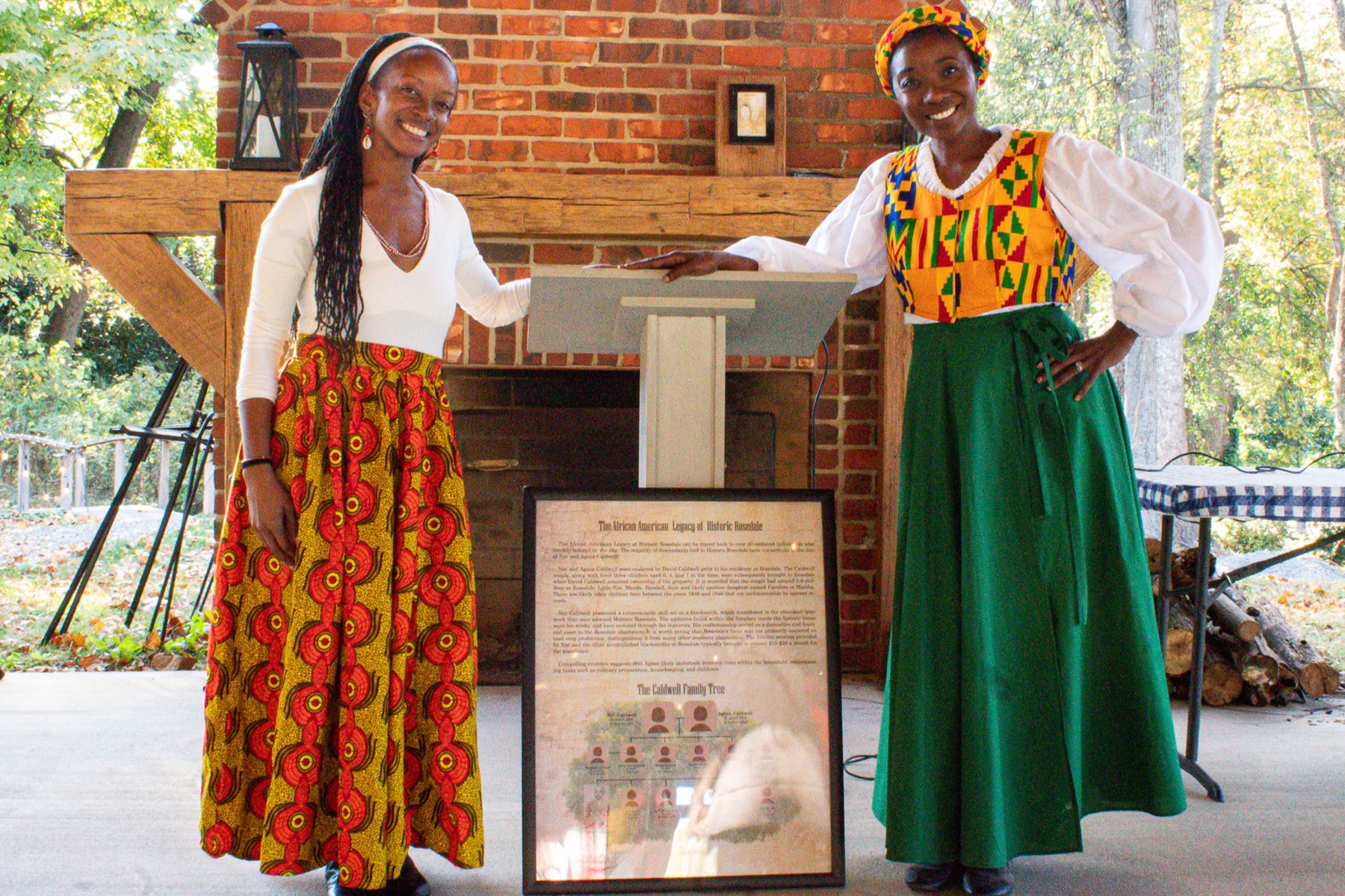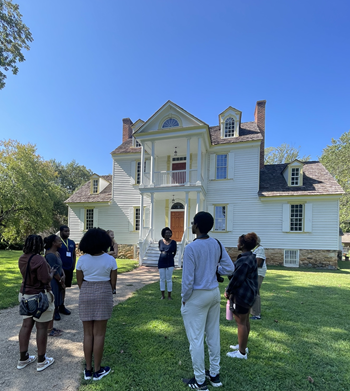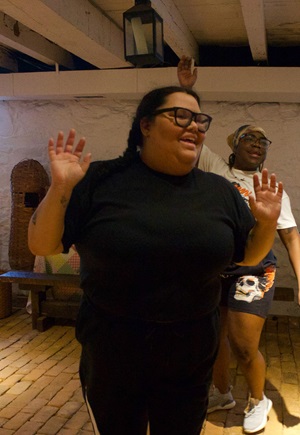
On a recent sunny afternoon, a cool breeze blew through the trees, picking up fall leaves and making them dance through the air. As leaves swirled, students in stunningly colorful outfits sang and clapped, encircling a magnificent oak tree in a vibrant ring of music and movement. UNC Charlotte dance and music students had traveled to Historic Rosedale, a former plantation in Charlotte, to perform African American Ring Shout, a tradition historically rooted in Africa and created by enslaved people in the Carolinas and Georgia. This powerful event, held on November 3, was the culmination of the students’ explorations in Associate Professor of Dance Tamara Williams’s class, "Ring Shout Dance Traditions," in collaboration with Dr. Sequina DuBose, Assistant Professor of Classical and Contemporary Voice.

Still practiced today, Ring Shout is the oldest African American performance tradition. An expression of religious fervor, cultural solidarity, and social resistance, its legacy includes a vast repertoire of Black American music and dance. In preparation for the program on November 3, students from both the music and dance departments studied Ring Shout past and present, learning symbolic movements, rhythms, spirituals, and freedom songs. Funded by the College of Arts + Architecture through a New South | Global South Project Grant, Williams (below, left) and DuBose (below, right) also led students through a collaborative educational experience focused on the historical, social, and political context of the “New South” ideology and how it determined socioeconomic structures for the Charlotte region and beyond.

In 2017, Williams developed the course "Reconstructing Ring Shout Traditions" to teach students Ring Shout movement vocabulary and its influence in American social and popular dances. In past years, students have traveled to South Carolina to study Ring Shout and Gullah culture and history and to perform on former plantations there.
 This year, the primary partnership was with Historic Rosedale on North Tryon Street. Historic Rosedale, built in 1815, is a house and grounds where enslaved and free African Americans lived and worked on the land. In coordination with Rosedale’s newly established African American Legacy Project, the event on November 3 paid homage to the enslaved persons that labored the land. During this event the names of the Rosedale enslaved were read aloud and honored with a ceremonial water libation.
This year, the primary partnership was with Historic Rosedale on North Tryon Street. Historic Rosedale, built in 1815, is a house and grounds where enslaved and free African Americans lived and worked on the land. In coordination with Rosedale’s newly established African American Legacy Project, the event on November 3 paid homage to the enslaved persons that labored the land. During this event the names of the Rosedale enslaved were read aloud and honored with a ceremonial water libation.
"We're honoring the people who worked on the land," said Williams. "It's a way to bring more awareness to the African American Legacy Project and the [Rosedale] site."
Earlier in the fall 2023 semester, the students toured Rosedale to better understand the lives of those who lived there. Touring the house and grounds beforehand gave the students a little insight into these people’s lives and why the Ring Shout tradition was so important.
 “When I was initially approached to participate in the Ring Shout performance, I found myself hesitating,” said Ashlyn Clark, a junior voice major (pictured right). “Growing up as a biracial individual, I hadn't had the opportunity to fully immerse myself in the experiences of Black culture. Most of my time was spent with my mom's predominantly white side of the family. However, upon my arrival at UNC Charlotte, I was determined to change that and truly delve into the richness of Black culture.”
“When I was initially approached to participate in the Ring Shout performance, I found myself hesitating,” said Ashlyn Clark, a junior voice major (pictured right). “Growing up as a biracial individual, I hadn't had the opportunity to fully immerse myself in the experiences of Black culture. Most of my time was spent with my mom's predominantly white side of the family. However, upon my arrival at UNC Charlotte, I was determined to change that and truly delve into the richness of Black culture.”
As a vocal performance major, Clark said she encountered significant challenges learning the Ring Shout dance.
“My previous dance experiences were primarily limited to high school musicals, and the intricate moves of Ring Shout posed a genuine struggle for me. Despite the initial difficulties, I am immensely thankful to Dr. DuBose and Professor Williams for entrusting me with the opportunity to partake in this captivating art form. Through this experience, I've had the privilege of meeting incredible artists who have further enriched my understanding of Black culture.”
Charity Williams, a senior dance major (pictured below in red skirt), said that even though the movement of Ring Shout is fast-paced, the performance of it brings her a special sense of peace and rootedness.
“Dancing on grounds that belong to ancestors, where energy is still stored and lively, is a rush. It’s amazing to be so connected. It’s very fulfilling!”

The nine student performers will also travel to Durham, North Carolina, to tour Historic Stagville, a former plantation in that part of the state, on December 1, with the hope of performing there in the near future.
Tamara Williams’s research centers around the systematic investigation and analysis of spiritual dances of the African Diaspora. In an effort to preserve the original movement and gestures of the Ring Shout tradition, Williams is reconstructing the earliest recorded dances of the Ring Shout, creating a formulated dance technique that highlights authentic movements of Ring Shout stemming from the Yoruba, Angola, and Akan cultures of West Africa. In her process, Williams analyzes the similarities in the West African ancestral dances and compares them to the movements performed in the Ring Shout by African Americans of the 17th and 18th centuries. Williams was recently awarded a Faculty Research Grant to go to Benin, Nigeria, to further her study of the direct cultural links of Ring Shout to practices in central and west Africa. Read more about her research in an article in Salvation South.
The final public performance of this semester’s Ring Shout program will take place on December 13 in Atkins Library for an Atkins Out Loud event.
“I aspire to honor our ancestors with my performance in Ring Shout,” said Clark, “and I hope that they would be proud of the dedication and passion we bring to this beautiful art form.”
Photos by Bethany Ivan and Rachel Vick. Costumes by Margarette Joyner.